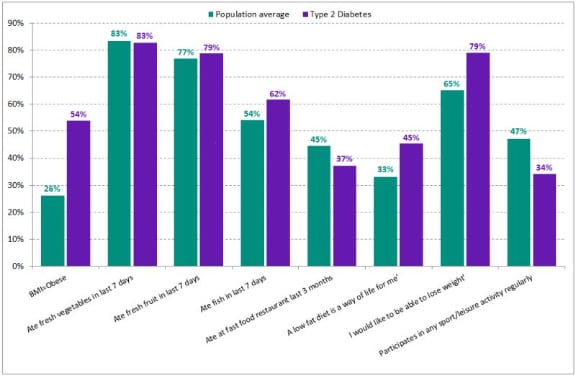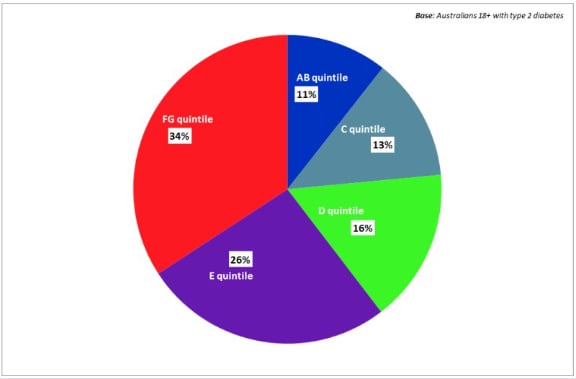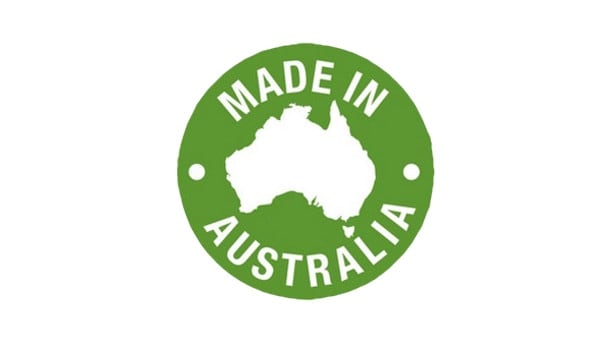According to data from Roy Morgan Research, people with type 2 diabetes are twice as likely as the average Australian to be classified as obese (54% vs. 26%) and markedly less likely to participate in regular or occasional sport or exercise (34% vs. 47%).
A more positive picture emerges when it comes to diet and attitudes to health and fitness: Australian adults with type 2 diabetes are slightly more likely than average to eat fresh fruit and fish and about average for consumption of fresh vegetables.

People with type 2 diabetes also display a greater tendency aspire to a low-fat diet (79% vs. the population average of 65%) and are less likely to visit fast-food restaurants.
Roy Morgan’s data supports Diabetes Australia’s assertion that age is a risk factor for being diagnosed with type 2 diabetes, finding that 83% of type 2 diabetics are aged 50 and above.
More concerning is the elevated incidence of type 2 diabetes among Australians from the lower end of the socio-economic spectrum. More than half of people with the condition are from the less affluent E and FG quintiles, while only 11% are from the well-off AB quintile.

It has been seen from other studies that Australians from disadvantaged circumstances often have limited access to health education, nutritious food and quality healthcare.
“Our figures show a 33% growth since 2007, and that’s just among people who know they have the condition. Obviously, this presents a growing challenge to Australia’s already stretched healthcare system,” said Michele Levine, Roy Morgan’s chief executive.
“With older and less affluent Aussies most at risk of developing type 2 diabetes, it makes sense for health bodies and/or government departments to devise a tailored campaign to raise awareness among these vulnerable groups, in an effort to minimise the spread of the condition and encourage a healthier lifestyle.”
NZ’s ‘pragmatic’ childhood obesity plan might not go far enough
New Zealand’s government has announced a wide-ranging package of initiatives to tackle childhood obesity, which is expected to overtake tobacco as the country’s leading preventable health risk next year.

The plan’s focus will be on food, the environment and being active at each stage of life – starting with pregnancy and early childhood, but said that there would be no controversial tax on sugar due to doubts over its effectiveness.
Health Minister Jonathan Coleman announced 22 separate initiatives, including prescribing more overweight children to diet and exercise interventions from the age of 4.
The New Zealand Food and Grocery Council welcomed the package, calling it a “pragmatic approach to a concerning problem”.
“Industry has long acknowledged it has a role to play, and is already doing a lot of work around reformulation of food and beverages, portion sizes, supporting education and physical activity programmes in schools and communities, and voluntarily restricting advertising and sales aimed at children,” said Katherine Rich, the council’s chief executive.
“We will work with the government to further those initiatives and help progress an integrated package that creates a healthy environment that enables people to make informed choices around the food they eat and their lifestyle.”
However, some public health experts have said the plan doesn’t go far enough, as have the opposition Labour and Green parties, which dismissed it as a collection of “half-baked policies.”
Australian food exports jump by nearly a third in the last year
Australian food and beverage exports have grown by almost 30% in the last year, according to The Australian Food and Grocery Council’s annual state-of-the-industry report.

The industry has also seen a lift in overall turnover and employment, the report also found.
“Food and grocery processing makes up almost one-third of Australia’s manufacturing sector and it is encouraging to see growth in both industry turnover and jobs,” said Gary Dawson, chief executive of the AFGC.
“An extra 3,183 jobs were created last year to bring direct employment in the industry to 322,000, with 41% of those in rural and regional Australia.
“Growth prospects for the future are strong, reflected in surging food exports in recent years. In 2014-15, processed food and beverage exports were up 28% or almost A$6bn (US$4.4bn) to A$26bn, and the trade surplus almost doubled to A$10bn.”
The falling Australian dollar and improved market access flowing from trade agreements have also improved the country’s export competitiveness in key market, as has its reputation for safe products, especially in Asia.
However, falling capital investment was singled out as a key area of weakness.
“Future growth to fully capitalise on improved market access and growing demand from middle-class consumers in the emerging economies of Asia and the Middle East will require a step change in investment in the food and grocery sector,” said Dawson.
